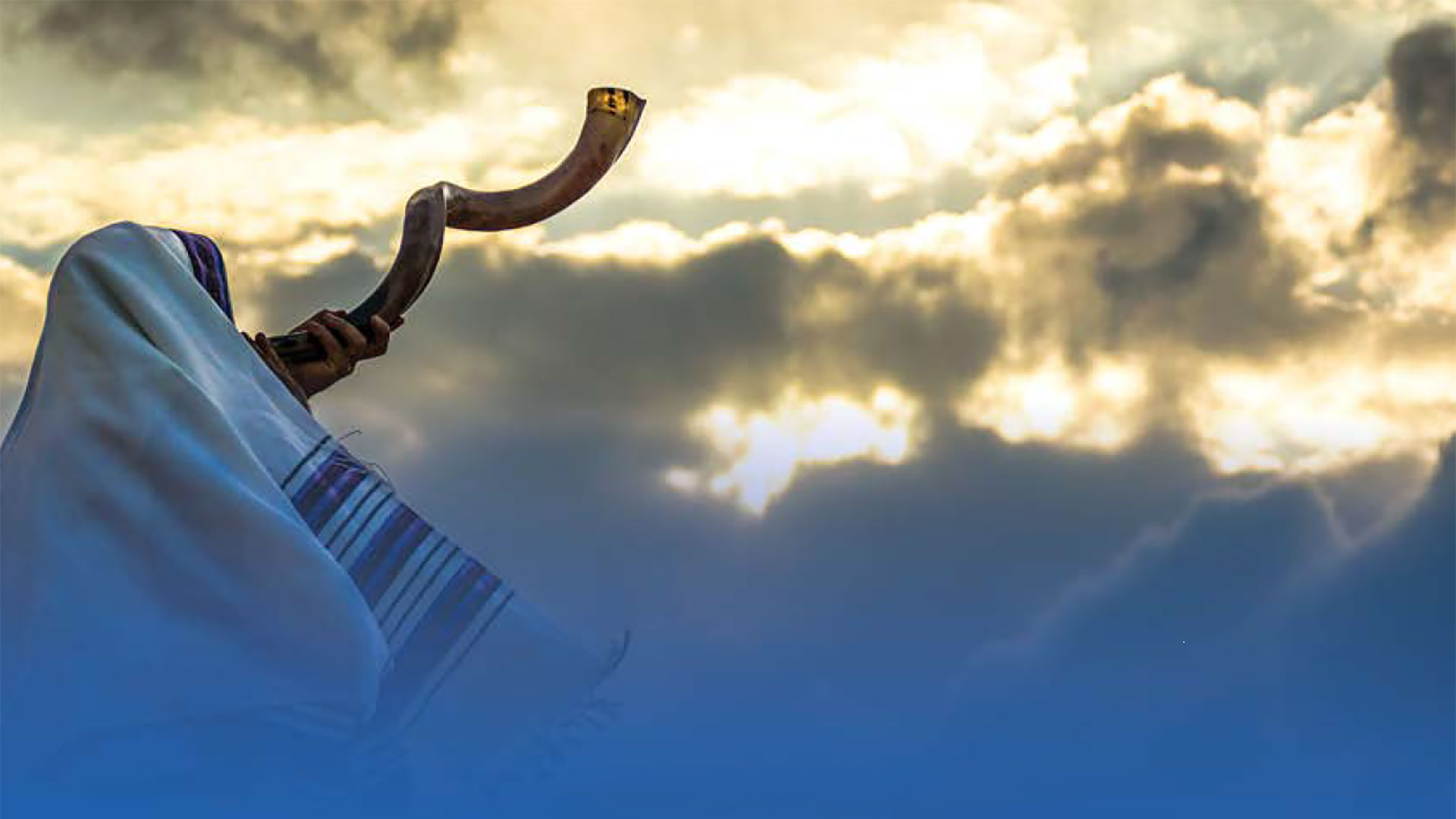The Story Behind Israel’s Flag
Prophetic symbol of Israel.

Theodor Herzl’s book, The Jewish State (1896), is considered to be the document that gave birth to the modern Zionist Movement. In that book Herzl proposed the design of a flag to represent a new Jewish state:1
“We have no flag, and we need one. If we desire to lead many men, we must raise a symbol above their heads. I would suggest a white flag, with seven golden stars.”
Herzl went on to explain that the white background would symbolize “the purity of our new life” while the seven stars would represent “the seven golden hours of our working-day.”
Herzl may have been a great political visionary, but he was no flag designer. His concept did not catch on with anyone. So, the next year he proposed an alternative. Once again he conceived of a white background, but this time he proposed a large Star of David in the center, with smaller gold stars at each point and a seventh star above this cluster. Reproduced below is an extract from his diary showing his drawing of this flag.2
The Wolffsohn Flag
During the preparations for the First Zionist Congress in Basel, Switzerland in 1897, Herzl raised the issue of the flag. He pressed for approval of his new idea, but the design did not ignite any excitement. Suddenly, one of Herzl’s close friends, David Wolffsohn, (185-1914) stood up and said, “Why do we have to search? Here is our national flag.” He then held up his prayer shawl which was white with a blue stripe along each margin. Here’s how Wolffsohn later described the incident:3
“At the behest of our leader, Herzl, I came to Basel to make preparations for the Zionist Congress. Among many other problems that occupied me then was… what flag would we hang in the Congress Hall? Then an idea struck me. We have a flag — and it is blue and white. The talith (prayer shawl) with which we wrap ourselves when we pray: that is our symbol. Let us take this talith from its bag and unroll it before the eyes of Israel and the eyes of all nations. So I ordered a blue and white flag with the Shield of David painted upon it. That is how the national flag, that flew over the Congress Hall, came into being.”
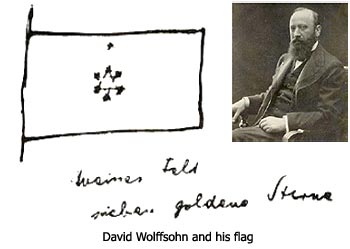
Over the years that followed, the Star of David banner with two blue stripes became the unofficial symbol of the World Zionist Movement. At the 18th Zionist Congress in 1933, held in Prague, the flag was officially adopted as the symbol of Zionism.
The Colors of the Flag
The first person to voice the idea that blue and white should be the colors of the Jewish people was an Austrian poet named Ludwig August Frankl (1810-1894). In 1864 he expressed his idea in a poem titled, “Judah’s Colors.”4
“When sublime feelings his heart fill,
He is mantled in the colors of his country.
He stands in prayer, wrapped
In a sparkling robe of white.
The hems of the white robe
Are crowned with broad stripes of blue;
Like the robe of the High Priest
Adorned with bands of blue threads.
These are the colors of the beloved country.
Blue and white are the borders of Judah.
White is the radiance of the priesthood,
And blue, the splendors of the firmament.”
Other Origins of the Flag
Actually, the flag design that David Wolffsohn came up with was one that had already been in circulation, although he most likely was not aware of it.
In 1882 Jews from Russia founded a town south of Jaffa named Rishon LeZion (“First to Zion”). It was funded in part by Baron Edmond de Rothschild. In the summer of 1885 the community started making plans to celebrate its third anniversary. One of the settlers, Israel Belkind, decided to make a flag for the occasion. Working with another settler, the two of them came up with the idea of a design that would look like a prayer shawl, with the Star of David in the center, between two blue stripes. The flag was adopted as the symbol of the town, and later, the word, Zion, was added in the center of the Star of David.5
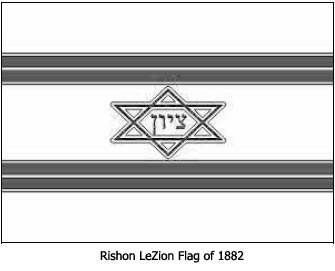
The fascinating thing is that people came up with a similar design here in the United States near the end of the 19th Century. For example, a father and son in Boston — Jacob and Charles Askowith — produced a flag like the Wolffsohn and Belkind flags in 1891 to be used as the symbol of the Bnai Zion Educational Society. It had blue stripes above and below a Star of David, with the word Maccabee, inscribed in the center.6
Six years later, in 1897, the same year that Wolffsohn designed the flag to be used at the First Zionist Congress, a man in the Harlem area of New York City made a flag that was identical to Wolffsohn’s. His name was Morris Harris. He was an immigrant from Russia. His ancestors have posted an article on the Internet that claims he was the designer of the flag of Israel.7
The story is that he was a member of a Jewish society that sent some delegates to the First Zionist Congress. When they returned to New York City, a welcome home party was planned for them. Mr. Harris, who was in the upholstery business, decided to make a flag to honor them. It turned out to be exactly like the flag Wolffsohn had designed and which had been displayed as the symbol of the Congress. His wife actually made the flag, and when she died in 1928, Mr. Harris erected a monument which proclaimed: “The first Zion flag was made by her.”8
Coincidence or Epiphany?
How could four people — one in Switzerland, one in Israel, and two in the United States — come up with the same flag design? Was it just a coincidence, or could it have been something supernatural in nature?
I would argue that the Lord moved on their hearts with the same design and did so to affirm the fact that their design was the one that should be adopted by the new state. I say this because the design of the flag of Israel was prophesied by Isaiah over 2,700 years ago (Isaiah 11:10):
“Then it will come about in that day
That the nations will resort to the root of Jesse,
Who will stand as a signal for the peoples;
And His resting place will be glorious.”
This passage goes on to say that at this time, the Lord will regather the Jewish people a “second time” (the first being the regathering from Babylon) from “the four corners of the earth” (Isaiah 11:11-12).
Look again at the verse quoted above (Isaiah 11:10). Isaiah says that “in that day” (his consistent term for the end times) a “signal” will be raised that will feature “the root of Jesse.” The Hebrew word for signal, nec, is a word that can be translated as signal, standard, banner, or ensign. So this verse is saying that in the end times a banner will be raised that will feature “the root of Jesse.” Jesse is, of course, the father of David. So, Isaiah is saying that the flag will carry the symbol of David and that it will act like a magnet to draw the Jewish people back to their homeland. The symbol of David is, of course, the Star of David, so the modern day flag of Israel represents a fulfillment of Bible prophecy.
The Adoption of the Flag
On May 14, 1948, when David Ben Gurion read the Israeli Declaration of Independence in Tel Aviv, Zionist banners hung from the ceiling on both sides of the podium, but no flag for the new state had yet been adopted.
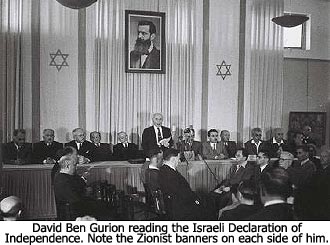
The Provisional Government was reluctant to adopt the design of the Zionist banner. They feared that Jews worldwide who were already using the Zionist flag at their meetings would be accused of double loyalty if the design was adopted as the official flag of Israel. So, for nearly six months, the new state did not have a flag.
There was fierce argument within the government as to the final design. Some desired a flag featuring a Menorah. Others lobbied for the Lion of Judah.9
Finally, Prime Minister David Ben Gurion decided to ask the public for its opinion. A design contest was initiated with the guideline that the flag should be blue and white in color, but other colors were not ruled out. About 170 proposals were submitted. On October 28, 1948, the Council of State adopted the design submitted by Richard Ariel.10 It was basically the Zionist symbol with a darker shade of blue. Another part of this decision was an agreement that the official seal of Israel would be the Menorah and that the Lion of Judah would appear on the flag of Jerusalem.
Other Symbols of Israel
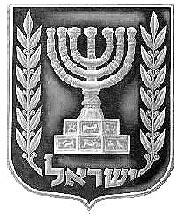 The Menorah — This is probably the oldest of all Jewish symbols. It has no parallel in heraldry and produces an immediate association with the subject it represents — the Temple in Jerusalem.
The Menorah — This is probably the oldest of all Jewish symbols. It has no parallel in heraldry and produces an immediate association with the subject it represents — the Temple in Jerusalem.
The symbol is incorporated in the official seal of Israel. The seal features the seven- branched candelabrum of the Temple. The two artists who designed the seal took as their model the depiction of the menorah in relief on the Arch of Titus in Rome. Their original design featured a white band at the top on which was emblazoned the seven golden stars Theodor Herzl had intended for the flag of the Jewish state. But the governmental committee in charge of selecting the design decided to eliminate the stars.
The olive branches express the state’s peaceful intentions. The menorah attests to the link of the Jewish people with their glorious past when a huge menorah stood in their Temple in Jerusalem. The inscription at the bottom says “Israel.” This seal is used on the official government documents of the state of Israel.
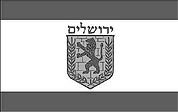 The Lion of Judah — The lion became associated with the Jewish people when Jacob on his death bed referred to the tribe of Judah as “a lion’s whelp” (Genesis 49:9). It was adopted as the symbol of the tribe of Judah, and later, when that tribe came to dominate Jewish life, it was identified with the Jewish people as a whole. It is used on the flag of Jerusalem. The design of that flag is similar to the flag of Israel, with a white background and dark blue stripes. But a depiction of the Lion of Judah replaces the Star of David in the center. The lion is displayed against a golden background that represents the Western Wall or “Wailing Wall” as it is known in the Western world. The word above the emblem is the Hebrew rendering of Jerusalem. The olive branches on each side represent the desire for peace, bringing to mind the biblical command to “pray for the peace of Jerusalem” (Psalm 122:6).
The Lion of Judah — The lion became associated with the Jewish people when Jacob on his death bed referred to the tribe of Judah as “a lion’s whelp” (Genesis 49:9). It was adopted as the symbol of the tribe of Judah, and later, when that tribe came to dominate Jewish life, it was identified with the Jewish people as a whole. It is used on the flag of Jerusalem. The design of that flag is similar to the flag of Israel, with a white background and dark blue stripes. But a depiction of the Lion of Judah replaces the Star of David in the center. The lion is displayed against a golden background that represents the Western Wall or “Wailing Wall” as it is known in the Western world. The word above the emblem is the Hebrew rendering of Jerusalem. The olive branches on each side represent the desire for peace, bringing to mind the biblical command to “pray for the peace of Jerusalem” (Psalm 122:6).
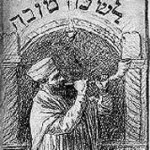 The Shofar — The shofar is mentioned frequently in the Hebrew Scriptures, the Talmud and rabbinic literature. The shofar was used in biblical times to announce the new moon (Numbers 10:10), holidays (Psalm 81:3), and the Jubilee year (Leviticus 25:10). The annual Feast of Trumpets, held on the first day of the seventh month, is termed “a memorial of blowing” (Leviticus 23:24), or “a day of blowing” the shofar (Numbers 29:1). The shofar was also employed in processions (2 Samuel 6:15), as a musical accompaniment (Psalm 98:6) and to signify the start of a war (Joshua 6:4). The blast of a shofar emanating from the thick cloud on Mount Sinai made the Israelites tremble in awe (Exodus 19:19).
The Shofar — The shofar is mentioned frequently in the Hebrew Scriptures, the Talmud and rabbinic literature. The shofar was used in biblical times to announce the new moon (Numbers 10:10), holidays (Psalm 81:3), and the Jubilee year (Leviticus 25:10). The annual Feast of Trumpets, held on the first day of the seventh month, is termed “a memorial of blowing” (Leviticus 23:24), or “a day of blowing” the shofar (Numbers 29:1). The shofar was also employed in processions (2 Samuel 6:15), as a musical accompaniment (Psalm 98:6) and to signify the start of a war (Joshua 6:4). The blast of a shofar emanating from the thick cloud on Mount Sinai made the Israelites tremble in awe (Exodus 19:19).
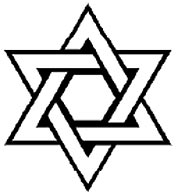 The Star of David — Many sources claim this symbol did not originate until the Middle Ages, but that is not true. It can be found on the frieze of the 2nd Century synagogue in Capernaum. It also appears as part of the 1st Century symbol of the Messianic Church, which combined the symbols of the menorah, the star of David and the fish.
The Star of David — Many sources claim this symbol did not originate until the Middle Ages, but that is not true. It can be found on the frieze of the 2nd Century synagogue in Capernaum. It also appears as part of the 1st Century symbol of the Messianic Church, which combined the symbols of the menorah, the star of David and the fish.
Notes
- Theodor Herzl, The Jewish State (Filiquarian Publishing, 2006), originally published in 1896, pp. 85-86.
- Dov Gutterman, “Israel — History of the National Flag,”
www.crwflags.com/fotw/Flags/il%7Dz1896.html. Accessed on March 5, 2008. - Alec Mishory, “The Israeli Flag,” The Jewish Virtual Library,
www.jewishvirtuallibrary.org/jsource/History/isflag.html, p. 2. Accessed on March 5, 2008. - “Blue and White and the Israeli Flag,” unsigned article on the website of Jewish Heritage Online Magazine, www.jhom.com/topics/color/flag.htm, p. 2. Accessed on March 5, 2008.
- Dov Gutterman, “Rishon LeZiyyon Flag,” www.crwflags.com/FOTW/FLAGS/il%7Dz1885.html, pp. 1-2. Accessed on March 5, 2008.
- Alec Mishory, “The Israeli Flag,” The Jewish Virtual Library,
www.jewishvirtuallibrary.org/jsource/History/isflag.html, p. 3-4. Accessed on March 5, 2008. - Madeline Harris Rabinowitz, “The Birth of the Flag of Israel: The Story of Morris Harris — Designer of the Flag of Israel,” www.flag-of-Israel.org, pp. 1-2. Accessed on January 20, 2008.
- Ibid., p. 2.
- Dov Gutterman, “Israel — History of the National Flag,”
www.crwflags.com/FOTW/FLAGS/il_hist.html, p. 2. Accessed on March 5, 2008. - Ibid., p. 3.


